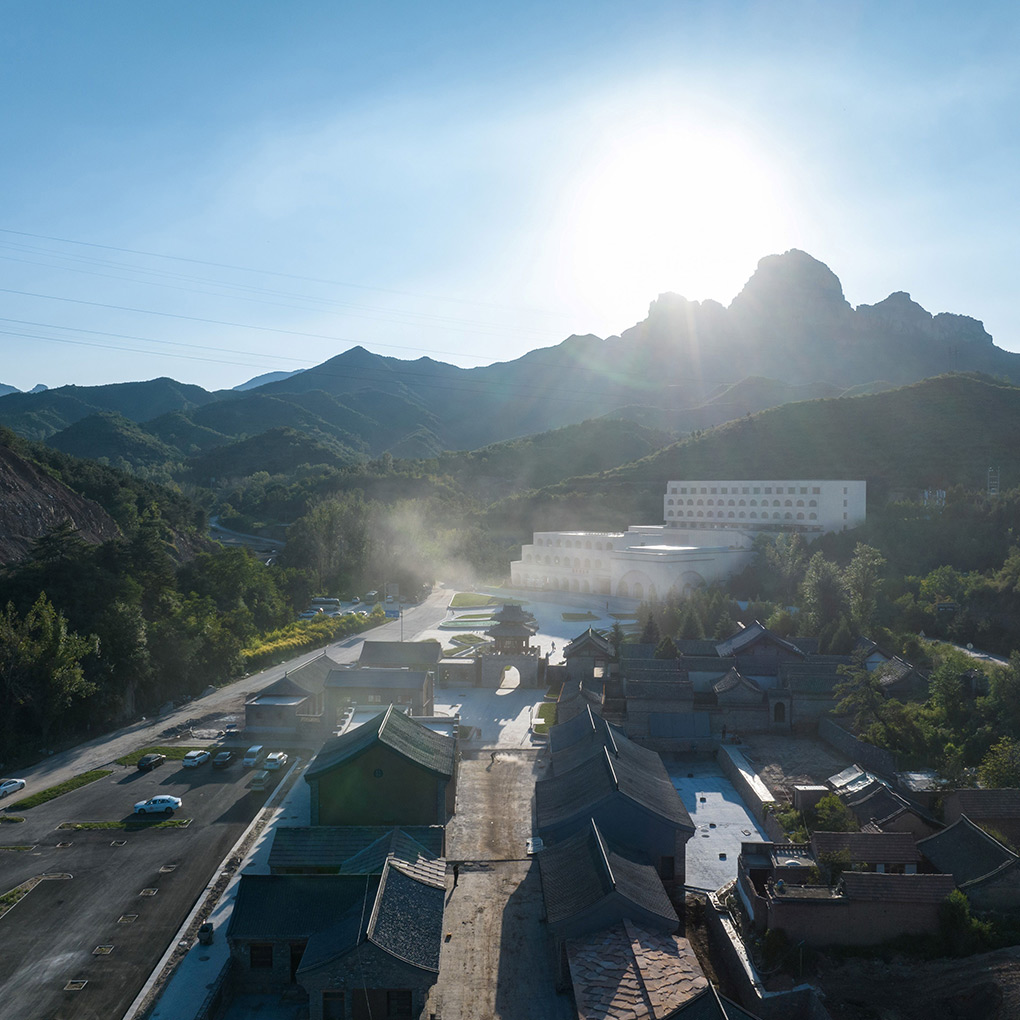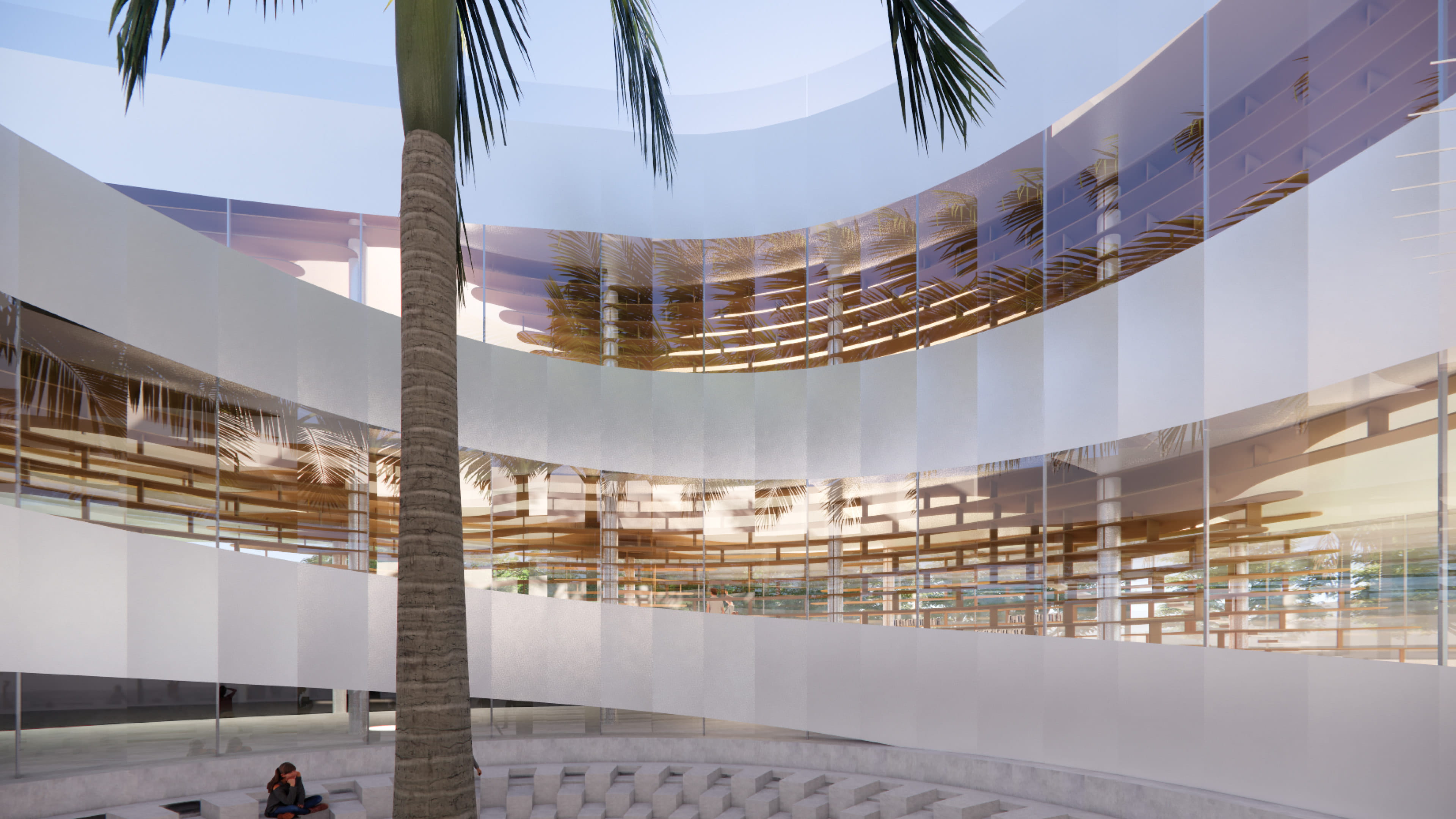
Exploring Natural Philosophy in a Cross-Cultural Context: A Discussion on the International Garden Festival's award-winning work "The Garden of Illusions"
Text_Liu Xiangcheng - Founding Partner of Atelier-, Master of the School of Architecture and Urban Planning of Tongji University, Master of Urban Design of the National University of Architecture of Belle Belle City, France, Advanced Master of Urban and Real Estate Management of ESSEC Business School, France
The International Festival des Jardins is the most internationally influential top landscape art festival, held at the Château de Chaumont-sur-Loire, France, from April to November every year, and is an annual international art event. The festival focuses on creativity, imagination, poetry and nature, and focuses on awakening public awareness of garden art. Each year, the festival proposes a different design theme, and about 30 garden art designs are selected from design proposals from all over the world, and then invited horticulturists, architects, and artists complete the design exhibition in the Chaumont castle garden, which is open to the public during the international garden art festival. Ten years ago, Wang Shu, winner of the China Pritzker Architecture Prize, was also invited to participate in the exhibition.
In 2022, the Château de Chaumont celebrates its 30th anniversary with the theme "Un jardin idéal" (The Garden of Ideals). "Dans unjardin d'illusion" by Shanghai-based design team Atelier-i (Ilimité Architectes) stood out from thousands of works around the world and became one of the 24 selected works this year, and the only Chinese work selected this year. This work excavates the concept of nature and ecological philosophy in traditional Chinese garden thought, and explores how to express the philosophy and aesthetics of Chinese gardens in the contemporary cross-cultural context, and integrates oriental philosophical narratives and universal ecological metaphors.
"Landscape" imagery and ideal realm
Located on the west side of Château Chaumont, the site is kite-shaped and surrounded by hedges 2 meters high. The main structure is composed of three concentric circles: the outer ring is composed of various colored plants, and the outer ring is composed of ropes to form a continuous mountain image, which is taken from the "Pingyuan Landscape" brushwork in the traditional Chinese landscape painting and the painter Mu Xi's "Eight Views of Xiaoxiang" in the late Song and early Ming Dynasty; Bamboo is planted in Central, and the shadows provide a place for visitors to travel and travel; The inner ring uses reflective stones to express the image of "water", adding light and shadow and agility. The creative presentation of the imagery of mountains, bamboo, water and stones, skillfully interdependent, and the scenery of a garden aims to convey the long-lasting meaning of traditional Chinese mountains and rivers to visitors from all over the world.
In response to the theme of the festival, "The Ideal Garden", the work appeals to ancient Chinese philosophical thought in search of an interpretation of the ideal: the landscape is the ideal, and the image of the landscape represents the idyllic ideal of life, the ideal of a free and uninhibited soul, and the social ideal of the unity of nature and man; Meilan bamboo chrysanthemum is ideal, and the image of bamboo represents a gentleman in China and is a symbol of ideal personality; The perfect circular geometric shape expresses the ancient Chinese cosmology of "heaven and earth and place" and the world view of "Taoism and nature", and embodies the perfect harmony and unity of heaven, earth, man and nature. The project applies the imagery of landscape, bamboo, and "the sky is round and the place is round" to the design, hoping to convey the concept of "ideal" in Eastern philosophy in the work.
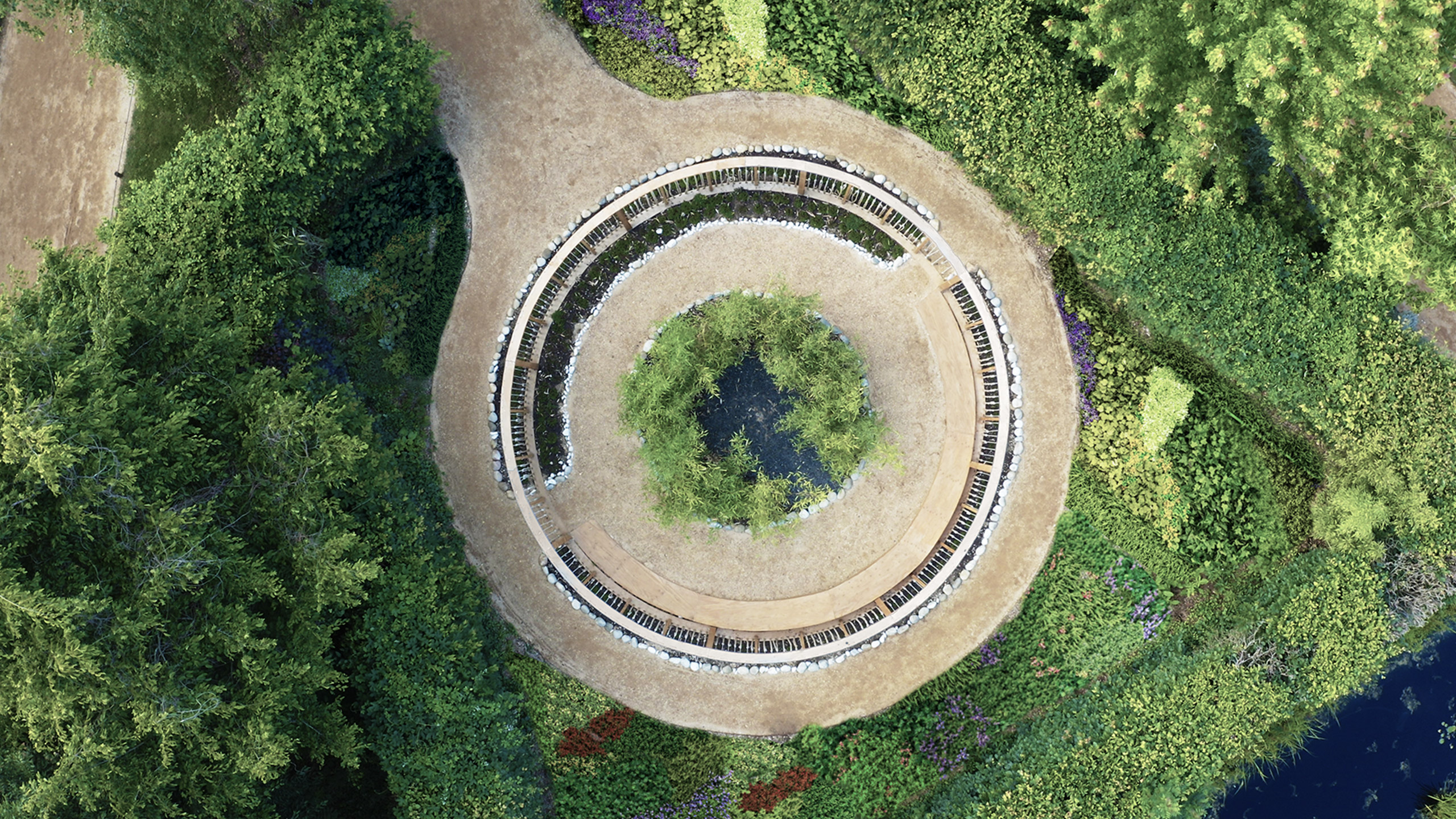
A bird's-eye view of OTtianhao Studio as a whole
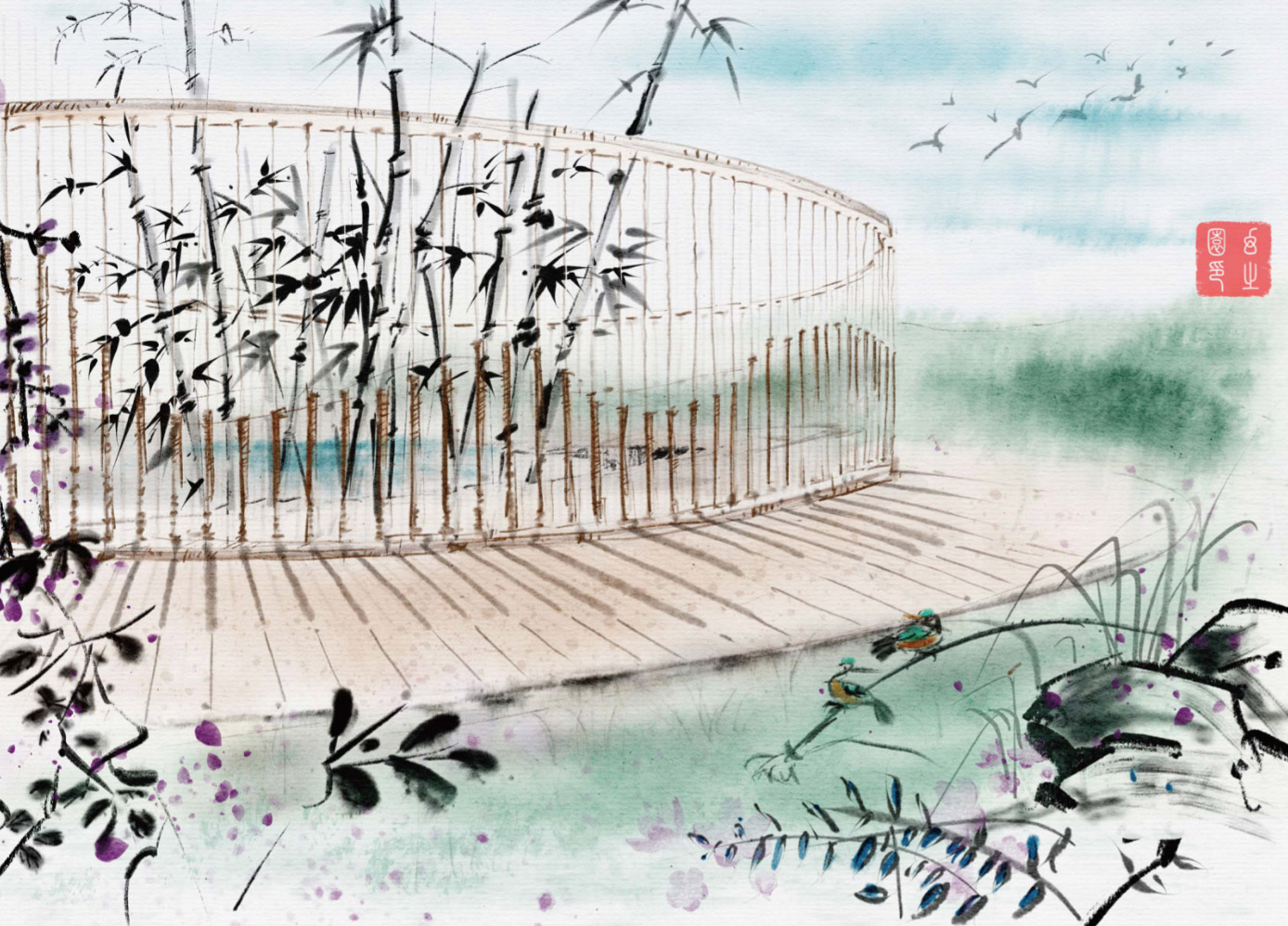
Project hand-drawn renderings ◎ Author
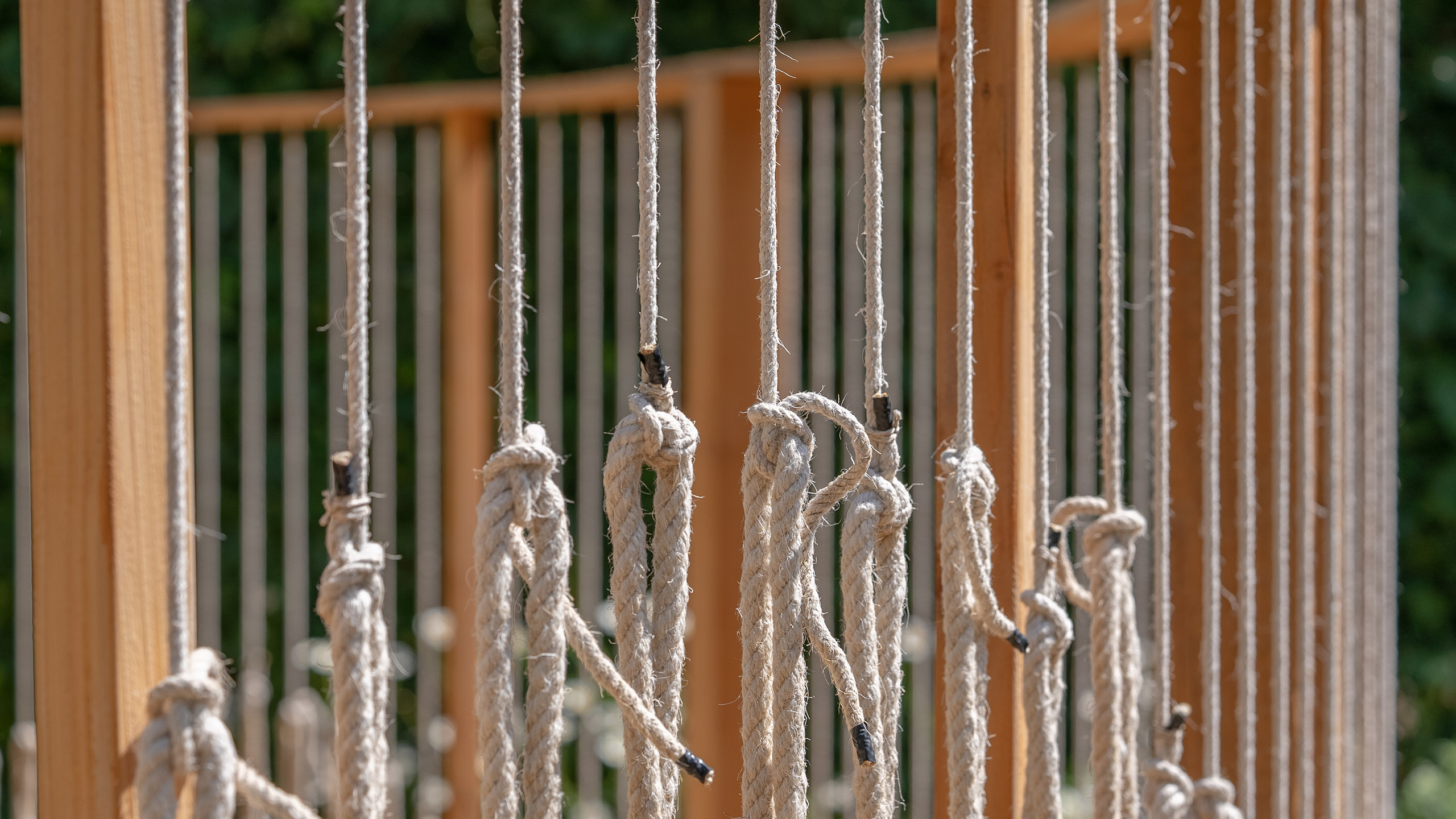
The rope knot is divided into two sections, and the flat section intersects ◎ Titianhao Studio
A wandering experience in a light and shadow narrative
In terms of creative techniques, the project draws on the landscape creation techniques in landscape painting and the construction methods of traditional gardens to construct a "magical" roaming experience.
Pingyuan, far-reaching, and high-reaching methods are the three perspectives of landscape painting, and Pingyuan refers to "looking at the distant mountains from the near mountains", which shapes the artistic effect of "the mountains follow the flat and far away" (3). The work uses the "Pingyuan method", and the façade interprets the ups and downs of the mountain through the change of the length of the hemp rope: 240 groups of hemp ropes are used to form a circle, the upper half of each group of hemp rope is a thin rope with a single diameter of 6 mm, the lower half is a thick rope with a diameter of 12 mm folded into double strands, and the upper and lower sections are intersected by flat joints. During the design process, the height of each flat section was precisely calculated. The key to Pingyuan's perspective lies in the change of light and shade, "the color of the lofty is clear, the color of the far-reaching is obscure, and the color of the flat is bright and obscure." The lofty momentum is abrupt, the far-reaching meaning overlaps, and the flat and distant meaning is melted and ethereal. (3) Therefore, the façade of the work uses spaced hemp rope to create a perspective effect of virtual and real, which is also the "obstacle scene" technique of Chinese gardens. From the "mountain" in front of the audience, the audience can see the "mountain" in the distance, and the shadow of the "mountain" changes with the daylight, projecting it in different angles and shapes in the garden.
Relying on the trend of the landscape in the garden, the Garden of Illusion has carefully created different light and shadow changes at different times of the day. The audience walks around in three concentric circles, starting from a colorful and fragrant world in the outer circle, passing through the symbolic minimalist world in the middle circle, and arriving at a calm world located in our hearts, feeling the obscure changes and the change of time in looking, smelling, hearing and touching, roaming in it makes visitors have a dream-like immersive experience across time and space, and are moved by this "Chinese artistic conception" that transcends language and culture.
An ideal work needs to maximize the viewer's experience through space and design itself, and stimulate thinking about philosophy and space in a limited space. Through the flow of lines, perspectives, light and shadow, the work creates a spatial "roaming" experience to provoke the viewer's thinking: conveying the instability in a stable state, with the aim of triggering the viewer's reflection on change and immutability, ephemerality and eternity in the process of roaming.
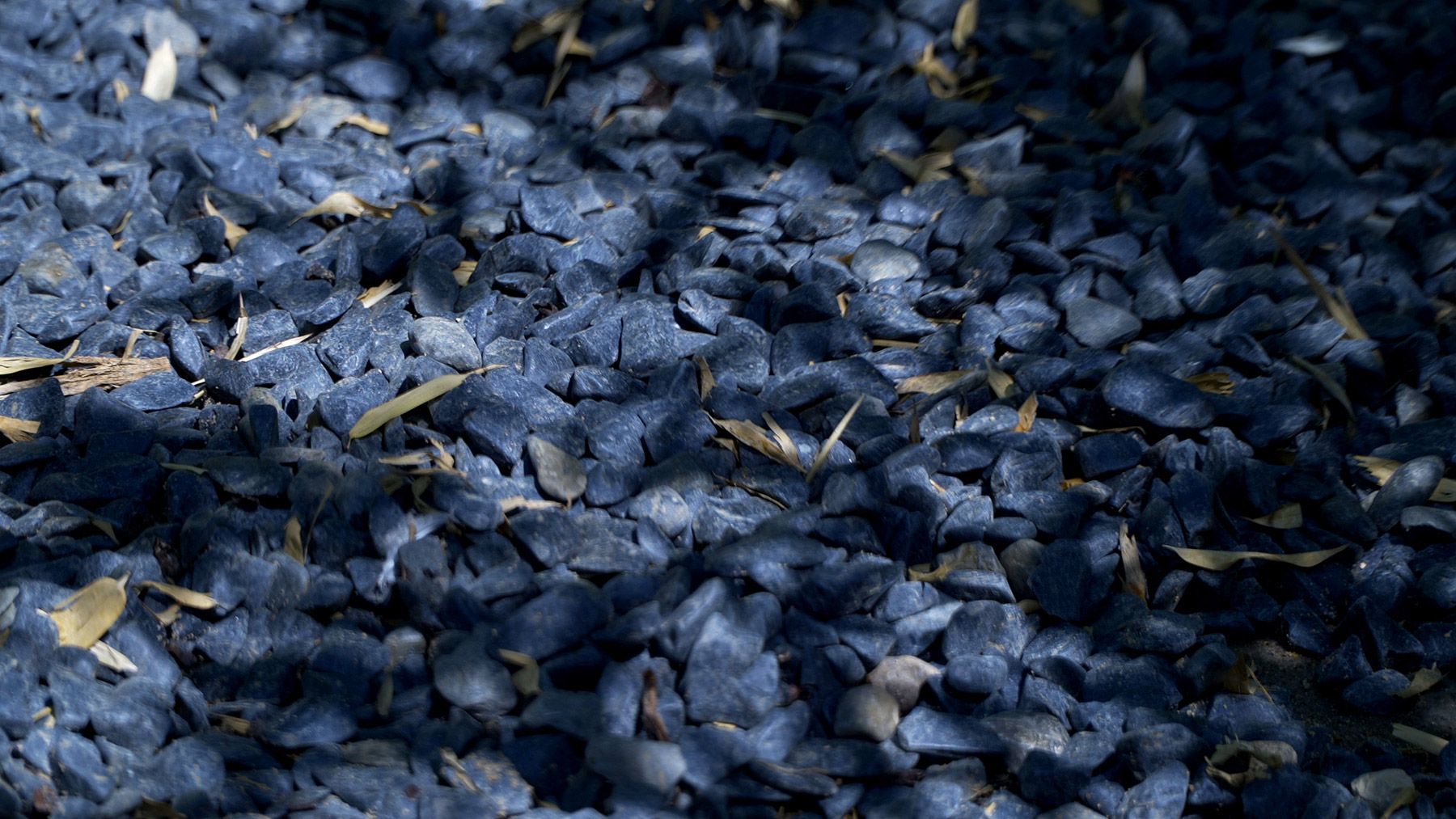
Light casts mottled shadows on pebbles (6) Titianhao worked
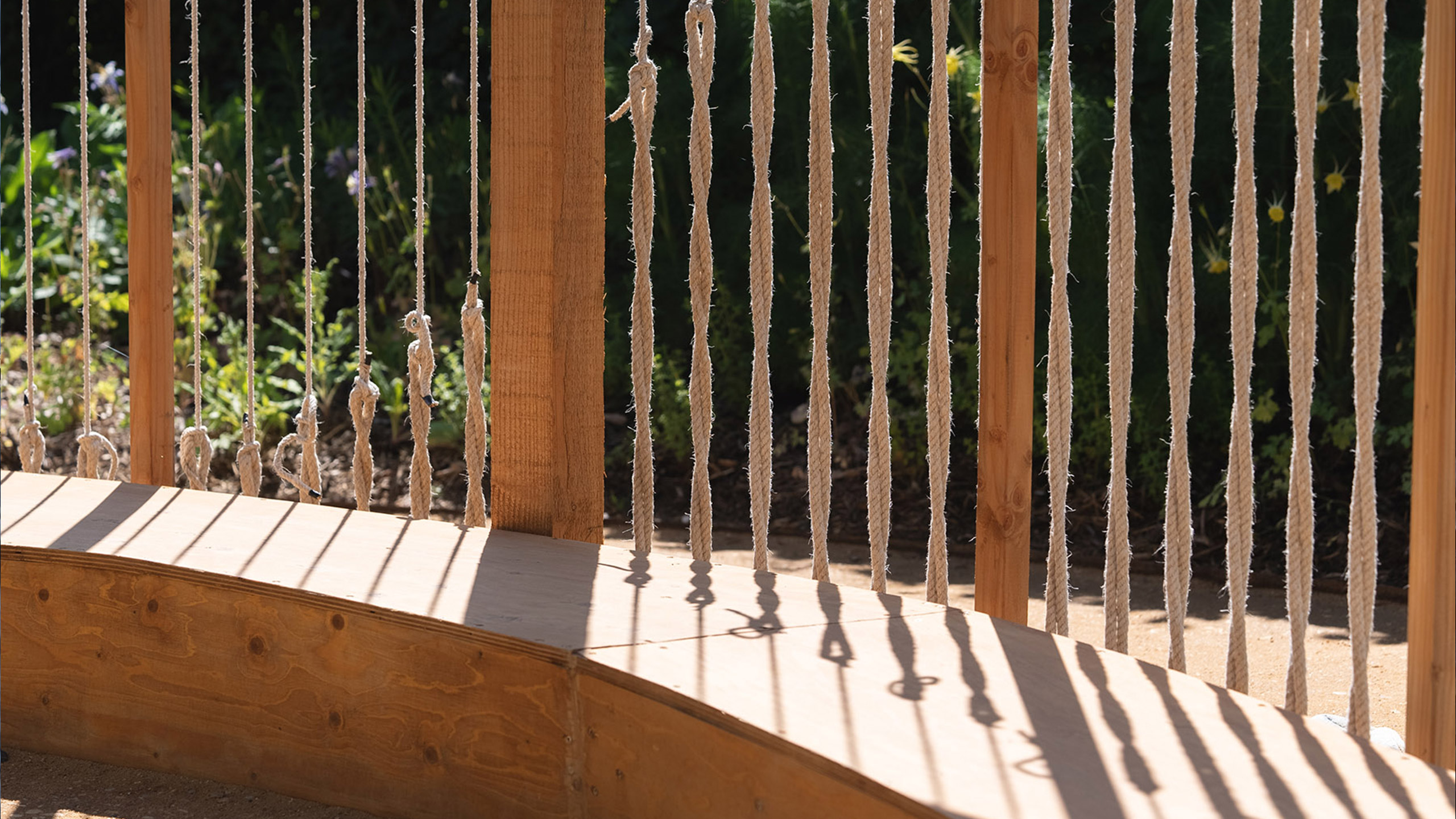
The hemp rope creates a perspective effect of virtual and real life ◎ Titianhao Studio
The "resilience" theory pursues multidimensional values
"Resilience Theory" is an internationally cutting-edge urban development theory, a future-oriented urban planning and design approach that aims to enable cities to better cope with the challenges of various natural disasters, man-made disasters and social changes, so as to maintain their sustainable development capabilities. The theory covers the health and well-being of citizens, urban planning and construction, emergency management, and sustainable development. Liu Xiangcheng, the chief architect, innovatively applies this international cutting-edge urban theory to spatial design and architectural project execution, and strives to realize the unity of ecology, society and economy of the work.
In terms of ecological resilience, the project attaches great importance to locality. The Loire region, where Château de Chaumont is located, is known as the "Garden of France", and the flowers used in the garden are made locally. All plants selected for the project are native to France, which can avoid invasive species and build a resilient ecosystem. Timber is also purchased from local suppliers to avoid energy and cost losses associated with transportation, while enhancing the interaction between local projects and local economies.
In addition, the project uses environmentally friendly materials, the building structure is all wood, and 95% of the building materials are recyclable. Timber is the main structural component of the garden. Eight 100 mm × 100 mm timbers are used as the main supports, and another 8 40 mm × 40 mm timbers are used as auxiliary supports to form the frame of the "screen". Hemp rope is the medium that connects wood, and the way the wood and hemp rope are constructed and connected is inspired by the traditional technique of fabric stitching in some rural areas of East China, while ensuring the precision, efficiency and beauty of the construction. The whole process of the project is hand-cut by modulus to reduce the energy consumption of construction. The public space is covered with bamboo forests and flowers to achieve a greening rate of 78%, forming an ecological micro-circulation in the landscape.
Economic resilience was also an important consideration, and the project team minimized the cost of construction, using easily dismantling and recyclable materials, and the exhibited works cost only 12,427 euros from design to construction. Social resilience emphasizes universal public participation and inclusive public resources. (5) This project experimentally explores the mechanism of "citizen co-creation", invites local primary and secondary school students in France to participate in the creative and construction process in a social practice way, stimulates young people's interest in architecture, and cultivates their hands-on ability and sense of community participation.
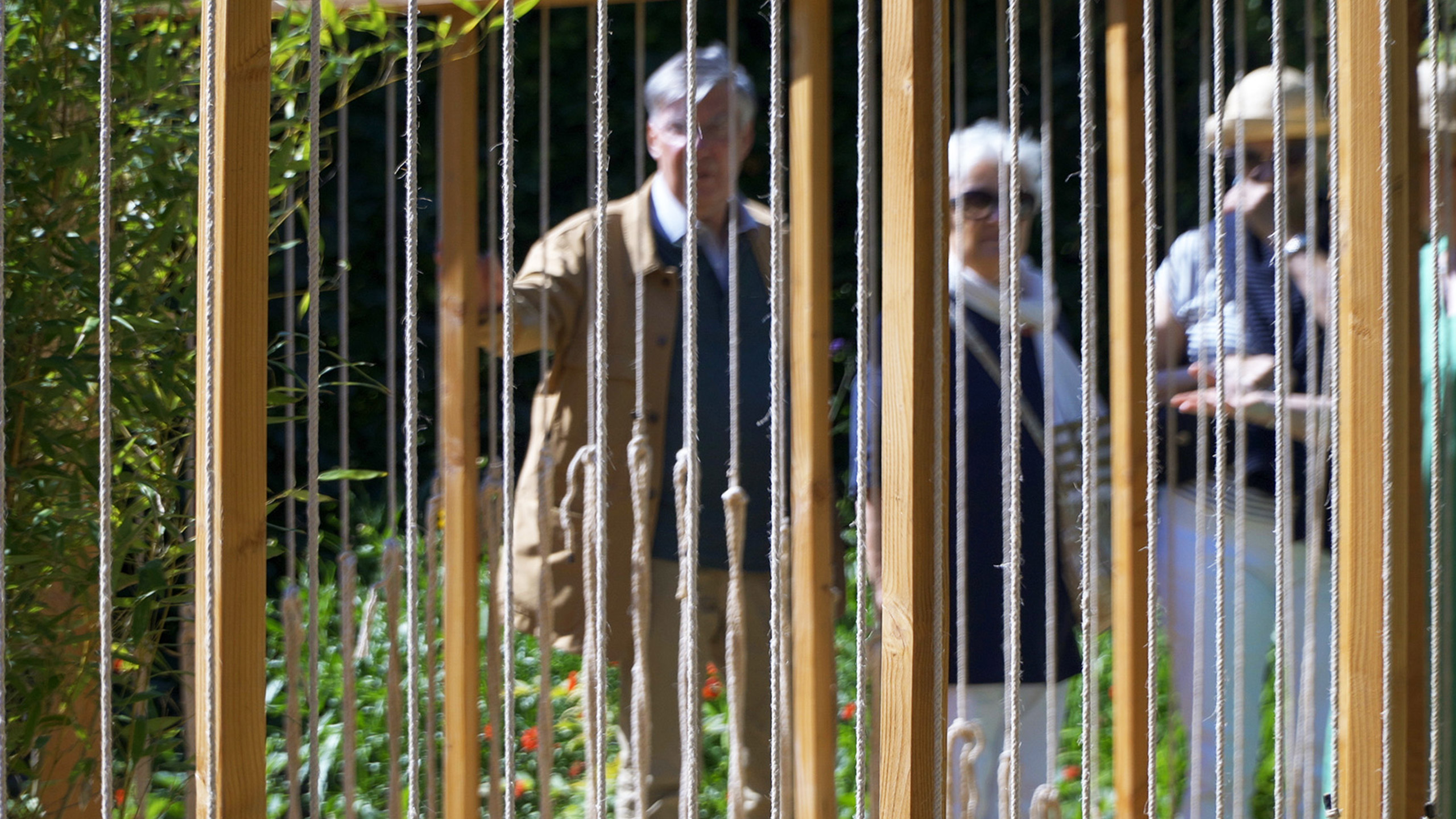
Visitors interact with the Garden of Illusions during the roaming ◎ Ttianhao Studio
Inspiration and reflection on cross-cultural practice
The work aims to present oriental culture and philosophy to visitors, so the design incorporates traditional cultural symbols such as landscapes, bamboo, and round heavens, but these symbols can only be decoded in a specific historical and cultural context. Therefore, in the context of cross-culture, designers need to think about how to convey the cultural meaning of China to audiences of different cultures in a diverse context, and avoid the strangeness of nationalism. The designer believes that Chinese elements are integrated into our background and blood, and we should refine the philosophy, spirit and concept in it to trigger cross-cultural dialogue on an equal footing. To this end, while using cultural symbols, the works actively try to transcend art forms and cultural contexts, and convey the ideas and artistic conceptions behind the techniques and symbols to audiences from diverse backgrounds.
The work attempts to construct a universal experience outside of semiotics. The works are expressed in the form of modern materials, such as simple and regular straight lines, circles and other geometric expressions. At the same time, through the universalization of form and style, the meaning of ancient Chinese philosophy runs through the works. Invoking the artistic conception of the "illusion" of the "Eight Views of Xiaoxiang" (i.e., the vagaries and disillusionment of clouds and smoke, light and shadow, or "Zen realm"), "The Garden of Illusions" uses the paths of three concentric circles and the projection of the façade to create a unique "fantasy journey", thus creating a universal and moving spiritual experience.
Second, it should provoke reflection on "big questions", both philosophical and social. The project uses the scattered perspective method of Chinese landscape painting and the "obstacle scene" method in the garden, so that the viewer can be full of imagination while watching, and enjoy the rich picture and associate with a broader artistic conception with the moving vision, (5) so as to construct an infinite space with undulating mountains and endless stretches in a limited space; At the same time, the wandering experience of changing scenery arouses the audience's perception of "change and immutability", as well as thinking about "ephemerality and eternity", which not only conveys the "Tao" of China's Lao Zhuang, which is that one life is two, two is three, and three is all things, and all things are in constant change, and it is also interconnected with Heidegger's thinking about existence—existence is a fluid process, not a frozen state. In addition, ecological issues are also a proposition that the work hopes to provoke the thinking of audiences around the world. The Xiaoxiang Eight Scenes Schema is a highly stylized expression of the Chinese artistic mind, which depicts nature, is content with nature, and expresses the feelings of homesickness in the twilight of rivers and mountains, representing the Chinese's deep understanding of the relationship between man and nature, and is also in line with the modern resilience theory that the work wants to convey.
By creating roaming experiences and stimulating philosophical reflections, audiences in cross-cultural contexts will not feel that "Oriental" and "Chinese" are a strange and "other" space for them, but will relate this experience more to their own inner world. The designer creates such an opportunity for dialogue and reflection in a cross-cultural context for the audience, to dissolve the gap between cultures.
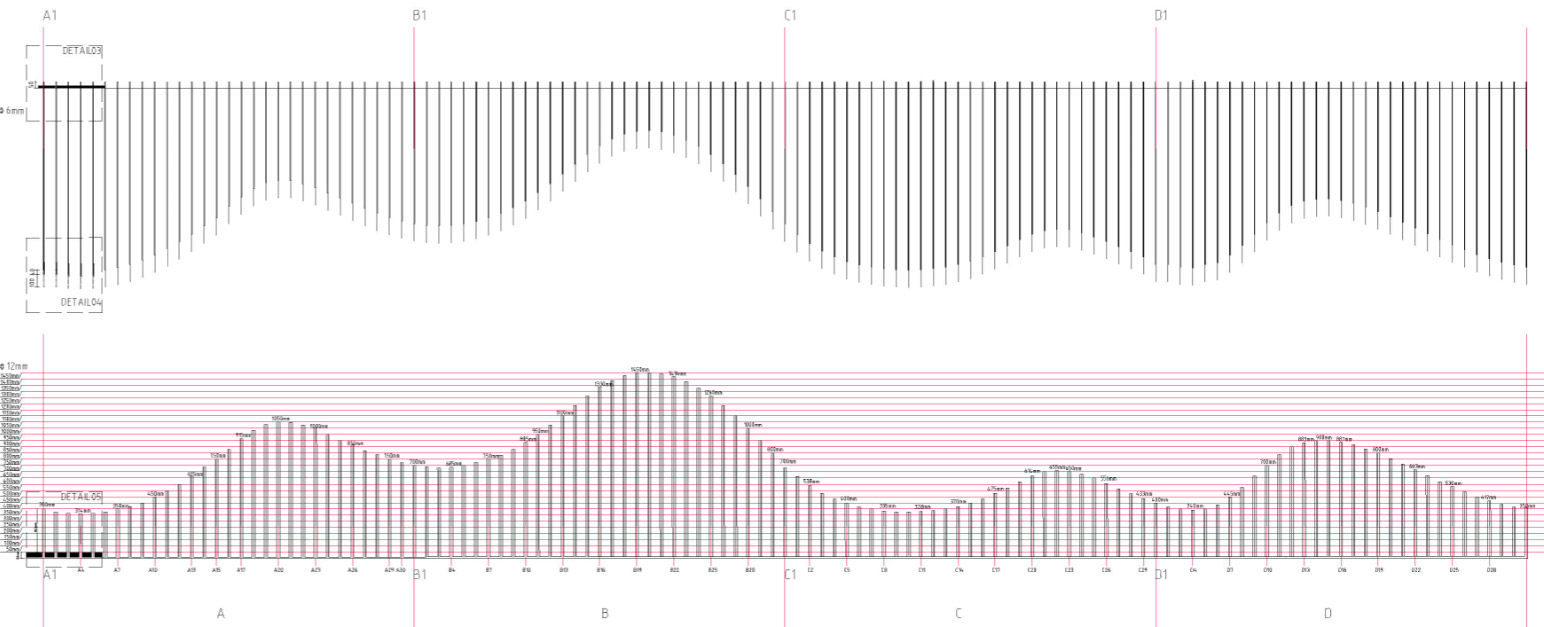
The project unfolds the elevation, and 240 knots of different heights interpret the undulating mountain landscape ◎ Yi Architecture/Atelier-i
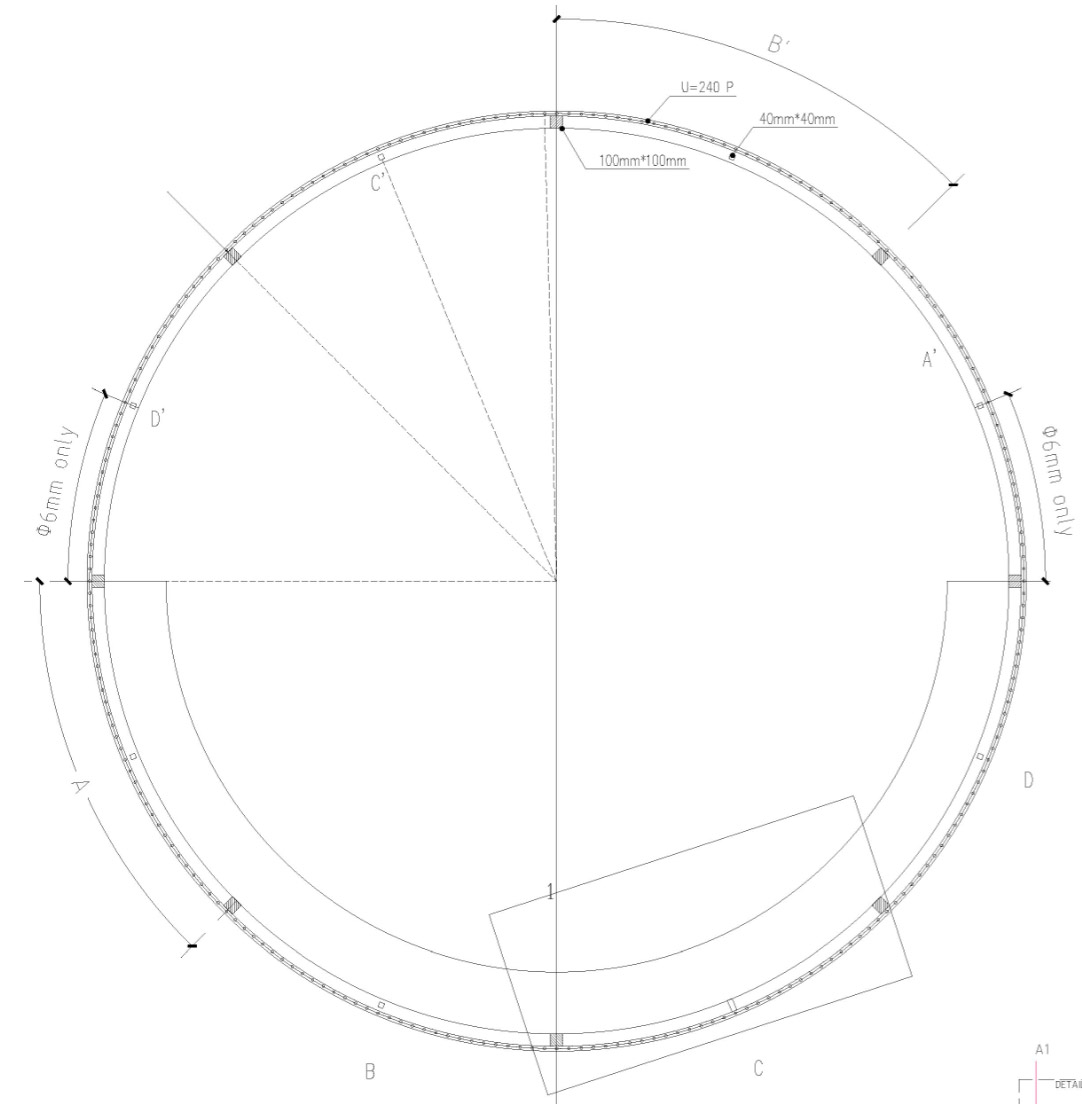
Project Floor Plan ◎ Eup Architecture / Atelier-i
References:
1. Chen Zhulong, ed., Selected Quotations of Landscape Painting, People's Fine Arts Publishing House, 2008, Chapter 2, Section 5, Page 31.
2. Shi Qi: The Beauty of Time and Light and Shadow in the Southern Song Dynasty "Eight Scenes of Xiaoxiang"[J].Chinese Aesthetics,2021(01):145-163.
3. Gao Yin, "A Brief Discussion on the Perspective, Relationship between Fiction and Reality and Sense of Space in Chinese Painting" [J], National Art Museum of China, 2011, No.76(04): 72-74.
4. Donald Preziossi, ed., The Art of Art History: A Critical Reader, Shanghai People's Publishing House, 2016, pp219-225.
5. (US) Edward S. W. Said: Oriental Studies, Joint Publishing Co., Ltd., 1999.
6.United Nations Human Settlements Programme (UN-Habitat) , CityRAP Tool, www.unhabitat.org.
7. UN-Habitat, New Urban Agenda Chinese Edition, 2017, http://www.habitat3.org.
8. ICLEI Association for Local Sustainable Development, 2019 Annual Work Report, eastasia.iclei.org.
9. Official website of the Chaumont International Garden Festival, https://domaine-chaumont.fr/zh-hans/home-cn.
10. Good, "Exploration of Natural Philosophy in a Cross-Cultural Context", https://www.gooood.cn/dans-un-jardin-dillusions-by-atelier-i.htm.
11. chine-info, « Entre idéal et illusion, un jardin chinois au domaine de Chaumont-sur-Loire ", 13 May 2022, Paris;
http://www.chine-info.com/static/content/french/LaChineenFrance/Art/2022-05-13/974721295432556544.html.
12. China News Service, "Chinese Architect Liu Xiangcheng: How to Achieve the "Commonality" of Eastern and Western Garden Art? Paris, 30 June 2022;
https://m.chinanews.com/wap/detail/chs/zwsp/9792665.shtml.
13. The Paper, "In the Post-Epidemic Era, How Can We Reconstruct Personal Space?" ——Interview with Architect Liu Xiangcheng, May 24, 2022, Shanghai,
https://m.thepaper.cn/newsDetail_forward_18721604.
14. CHIU Che-Bing, "Looking Back and Looking Forward - Remembering the 20th Château Chaumont International Garden Art Festival",
https://designverse.com.cn/content/IP/article/hui-gu-he-zhan-wang-ji-di-20-jie-fa-guo-xiao-meng-cheng-bao-guo-ji-hua-yuan-yi-shu-jie-10-en.





